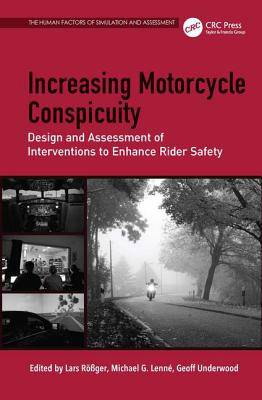
- Afhalen na 1 uur in een winkel met voorraad
- Gratis thuislevering in België vanaf € 30
- Ruim aanbod met 7 miljoen producten
- Afhalen na 1 uur in een winkel met voorraad
- Gratis thuislevering in België vanaf € 30
- Ruim aanbod met 7 miljoen producten
Zoeken
Increasing Motorcycle Conspicuity
Design and Assessment of Interventions to Enhance Rider Safety
Lars Rößger, Michael G Lenné
€ 305,45
+ 610 punten
Uitvoering
Omschrijving
It's a widely recognised trend that powered-two-wheelers' (PTWs) use has been steadily increasing and is projected to increase further. While providing benefits to the community in the form of reduced traffic congestion and environmental benefits, the risks to PTW riders remain and visibility will always be a key issue. Increasing Motorcycle Conspicuity aims to illustrate how driving simulation, field studies and laboratory experiments can be used to improve rider safety through the design and evaluation of a range of safety measures. The book outlines the factors that contribute to PTW visibility and detection by car drivers, and presents case studies to illustrate how the various methods can be used to explore the contribution of these factors. The final chapter of the book highlights the utility of a simulation-based approach to improving PTW safety and discusses this method's future applications. The case studies collected within the volume cover phases of the design of conspicuity treatments and provide a broad spectrum of empirical strategies for assessing the interventions. The book is most directly relevant to researchers and applied scientists from the fields of traffic/transportation psychology and human factors, as well as to practitioners from the traffic safety sector.
Specificaties
Betrokkenen
- Auteur(s):
- Uitgeverij:
Inhoud
- Aantal bladzijden:
- 258
- Taal:
- Engels
- Reeks:
Eigenschappen
- Productcode (EAN):
- 9781472411129
- Verschijningsdatum:
- 28/03/2015
- Uitvoering:
- Hardcover
- Formaat:
- Genaaid
- Afmetingen:
- 156 mm x 234 mm
- Gewicht:
- 539 g

Alleen bij Standaard Boekhandel
+ 610 punten op je klantenkaart van Standaard Boekhandel
Beoordelingen
We publiceren alleen reviews die voldoen aan de voorwaarden voor reviews. Bekijk onze voorwaarden voor reviews.











